Abstract
Twenty-three T-cell neoplasms were investigated for their reactivity with the OKT monoclonal antibodies and expression of certain cytochemical markers. Fourteen neoplasms with diverse histopathologic features, T-cell chronic lymphocytic leukemia, mycosis fungoides, the Sézary syndrome, T-immunoblastic sarcoma, and a pleomorphic large-cell lymphoma, expressed the T helper cell phenotype, OKT3+T4+. Nine other neoplasms displayed marked inter- and intra- tumor heterogeneity. Seven of these cases, lymphoblastic lymphoma, T-cell acute lymphoblastic leukemia, and tumors with feature of T-immunoblastic sarcoma or the multilobated lymphoma of Pinkus, expressed intrathymic phenotypes. The other 2 cases, a lymphoblastic lymphoma and a so-called Lennert's lymphoma, expressed the previously undescribed OKT3+T10+ phenotype. These studies demonstrate that the T-cell malignancies are divisible into phenotypes corresponding to normal maturational stages of T-cell differentiation and functionally distinct T-cell subsets. Such studies should provide a basis for understanding the biologic heterogeneity, clinical diversity, and significance of the variable cytomorphologic characteristics of T-cell malignant tumors and assist in the further delineation of normal human T-cell heterogeneity.
Full text
PDF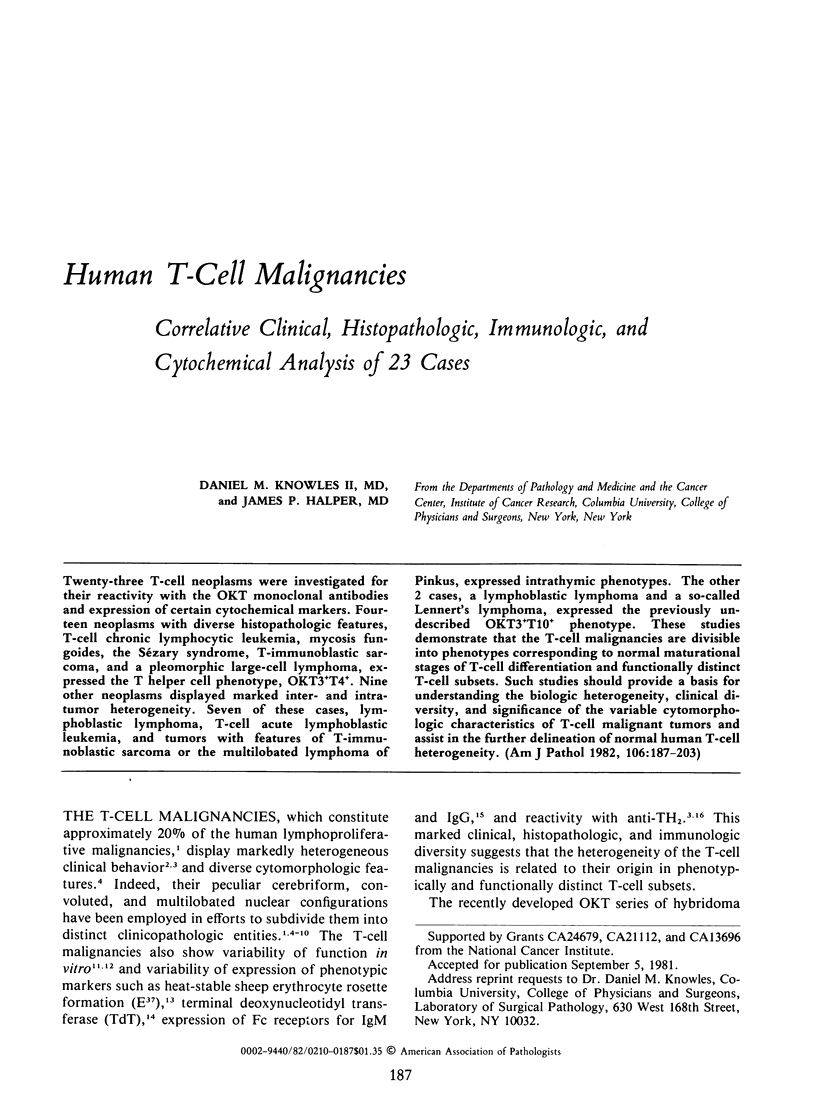
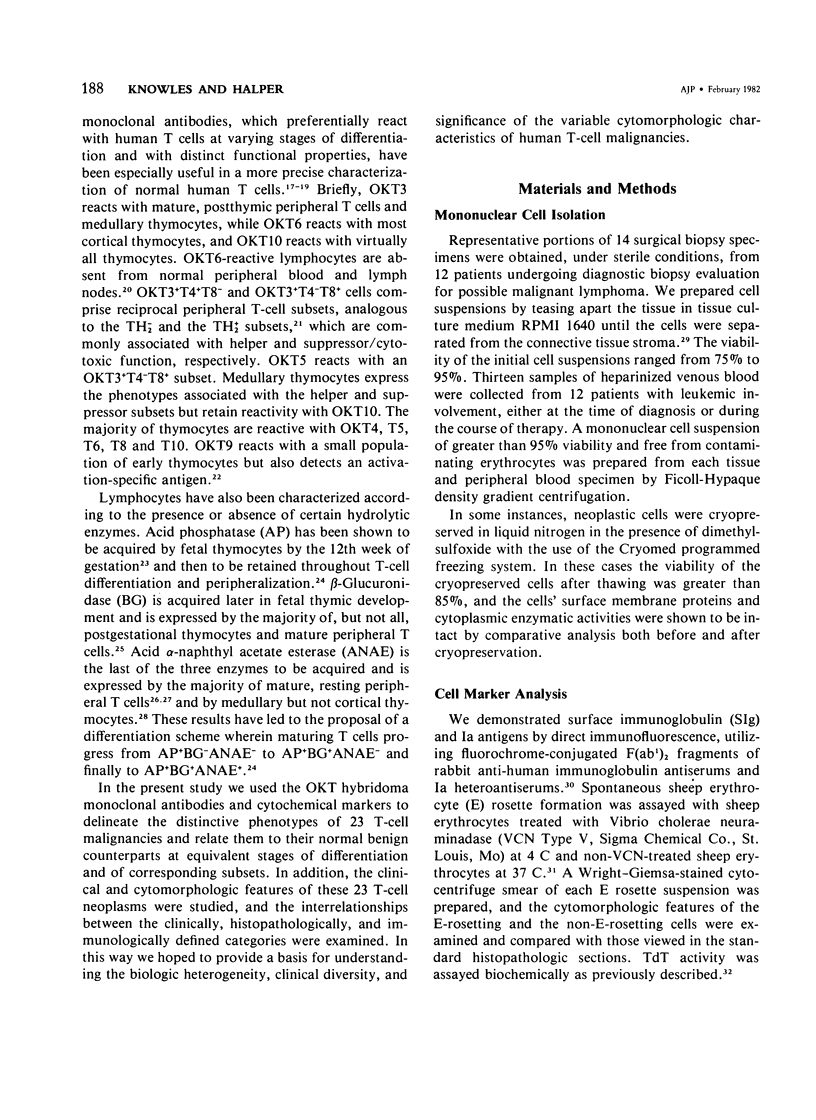
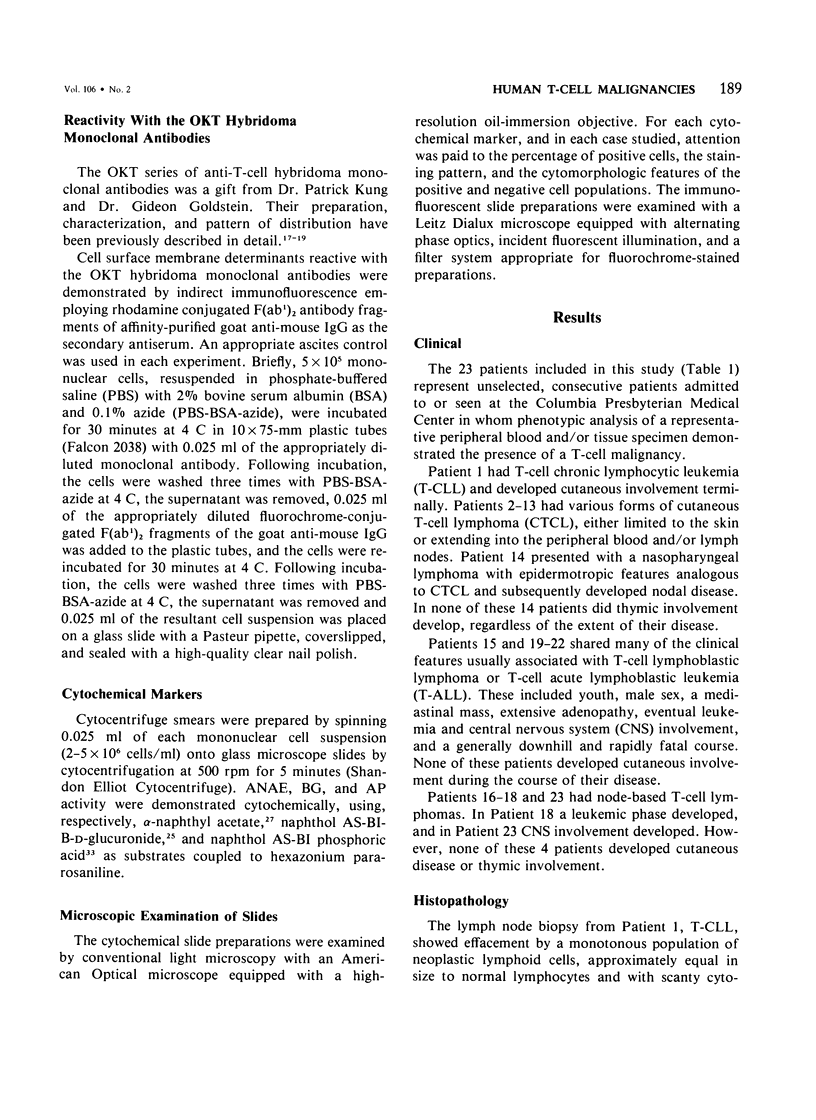
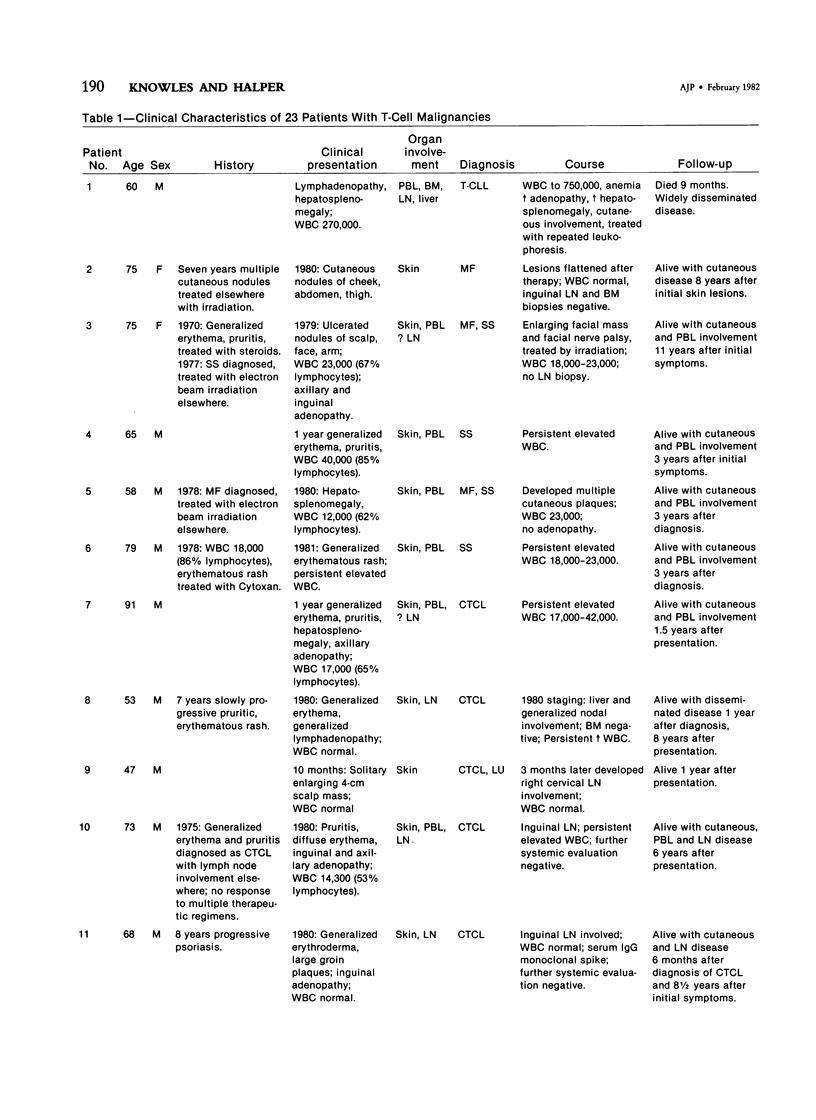
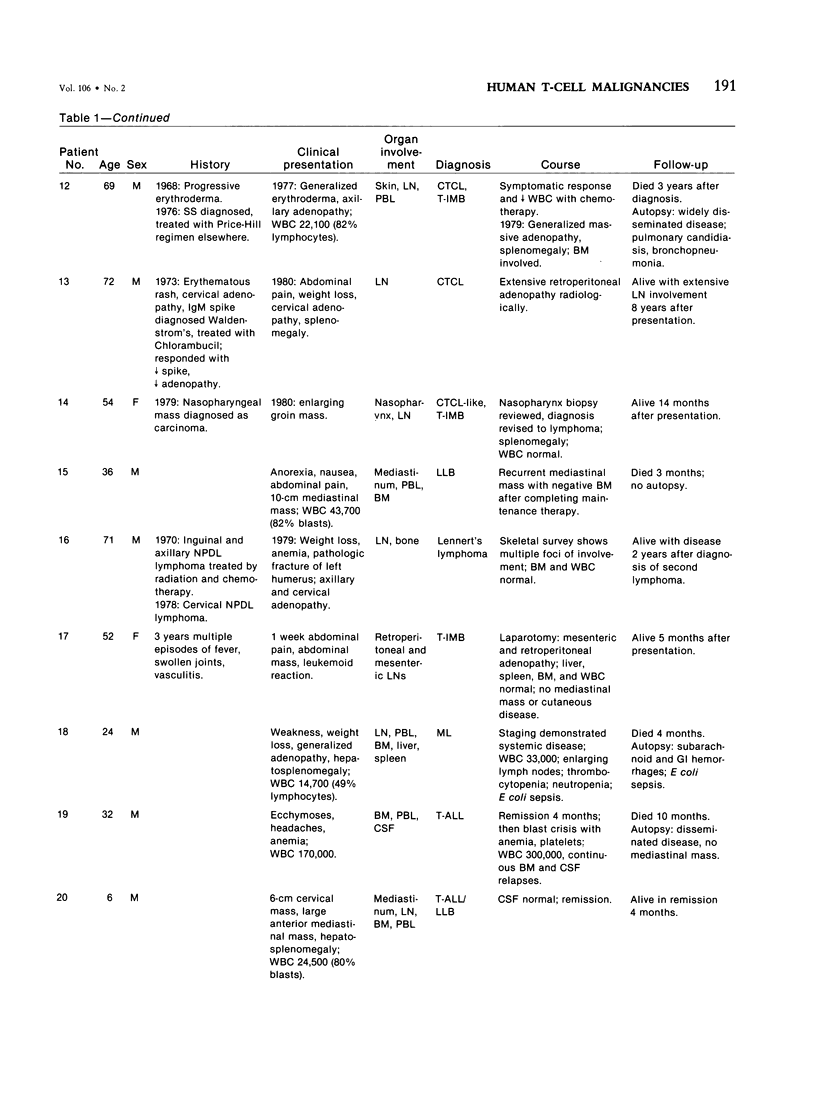
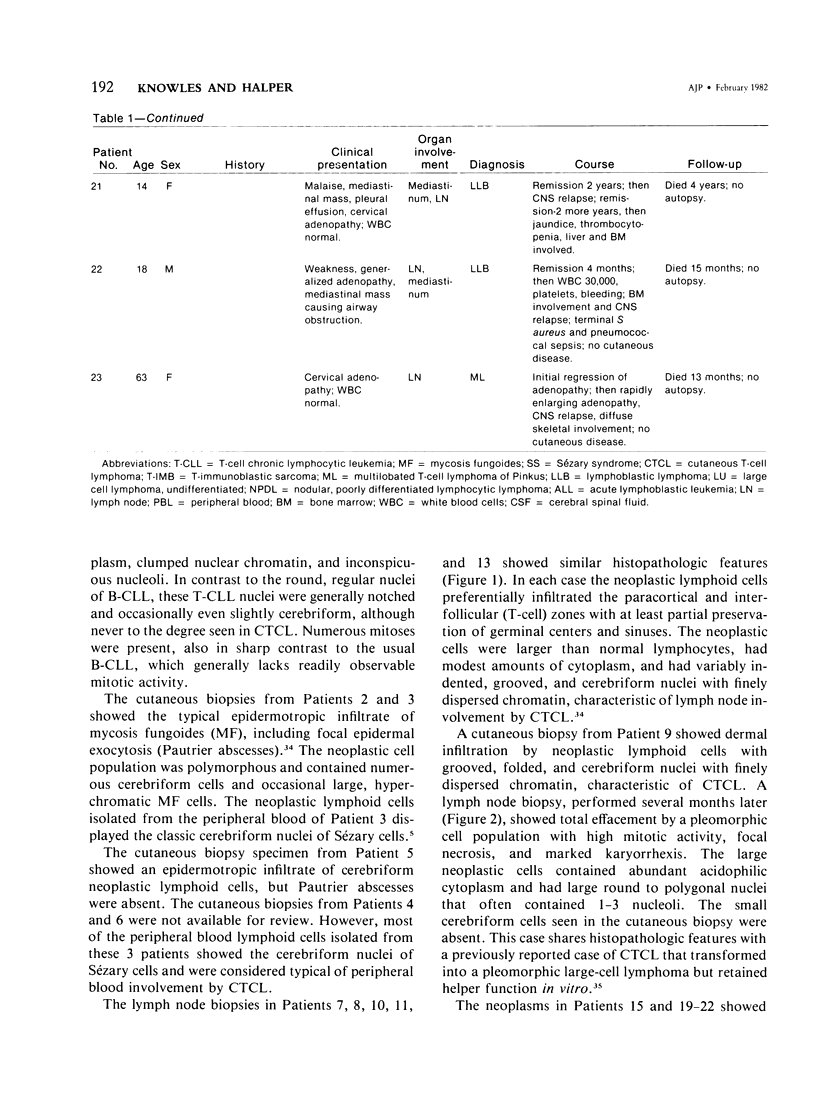
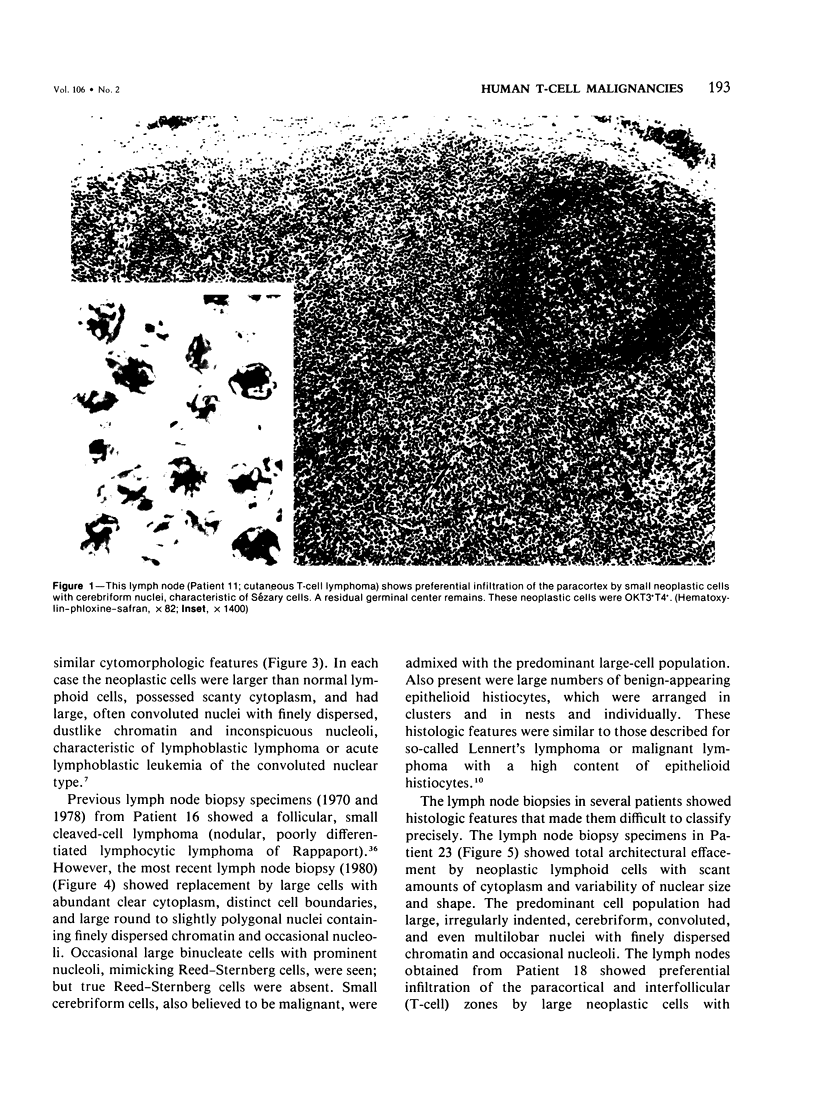
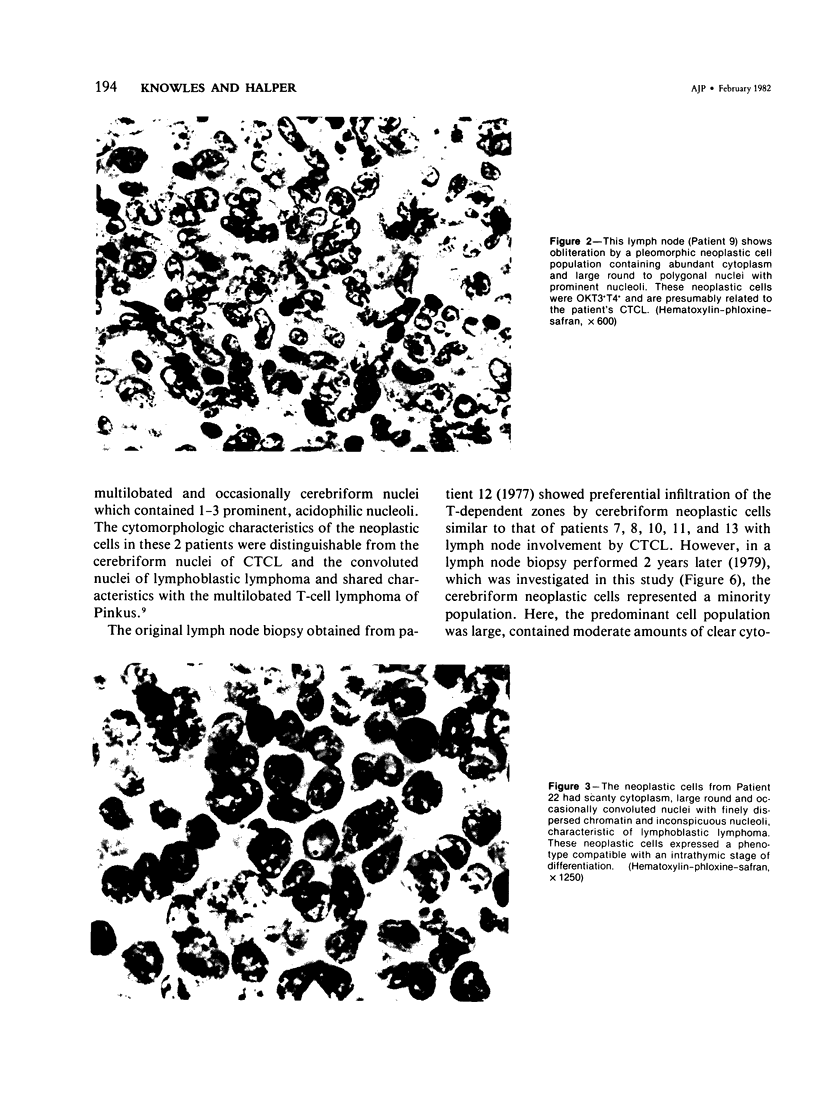
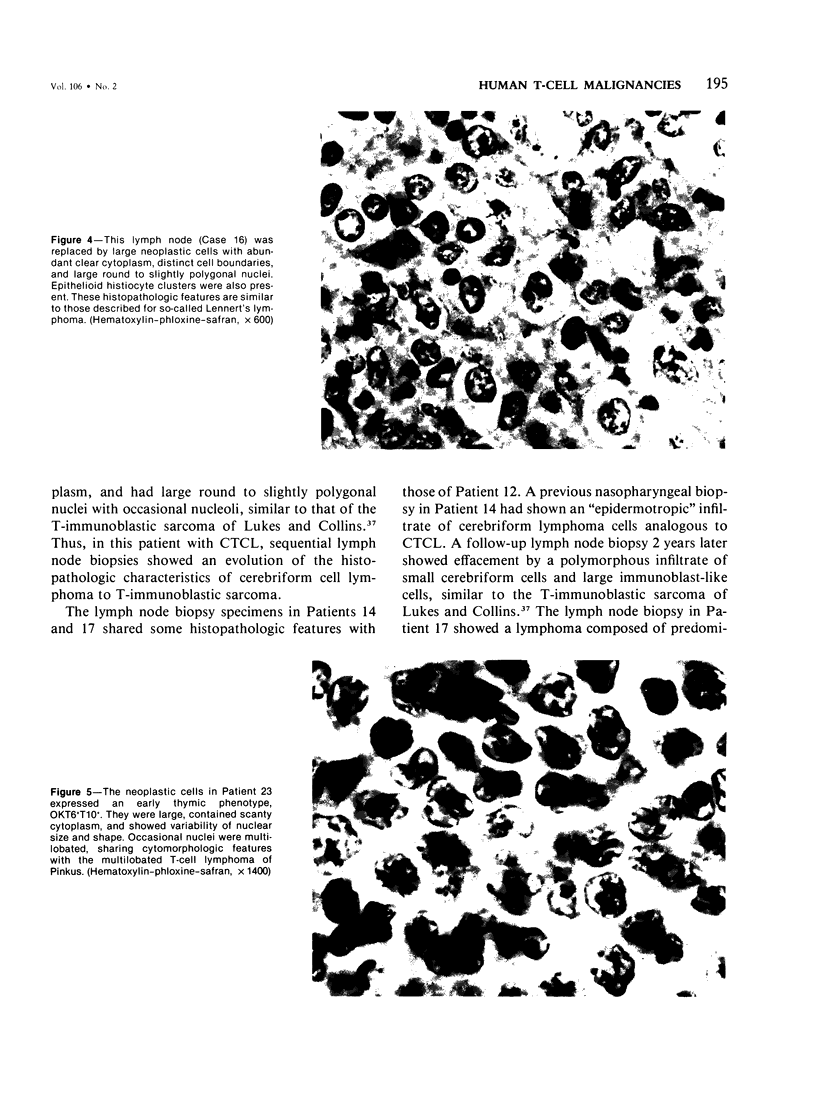
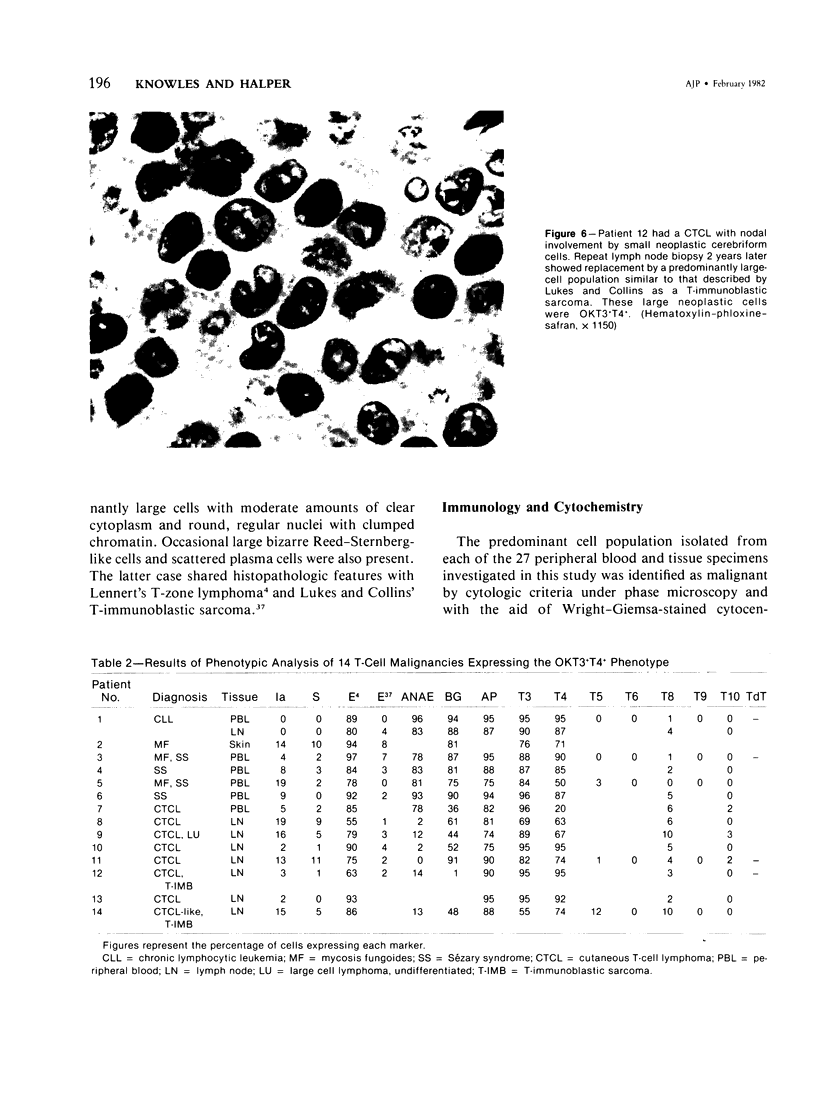
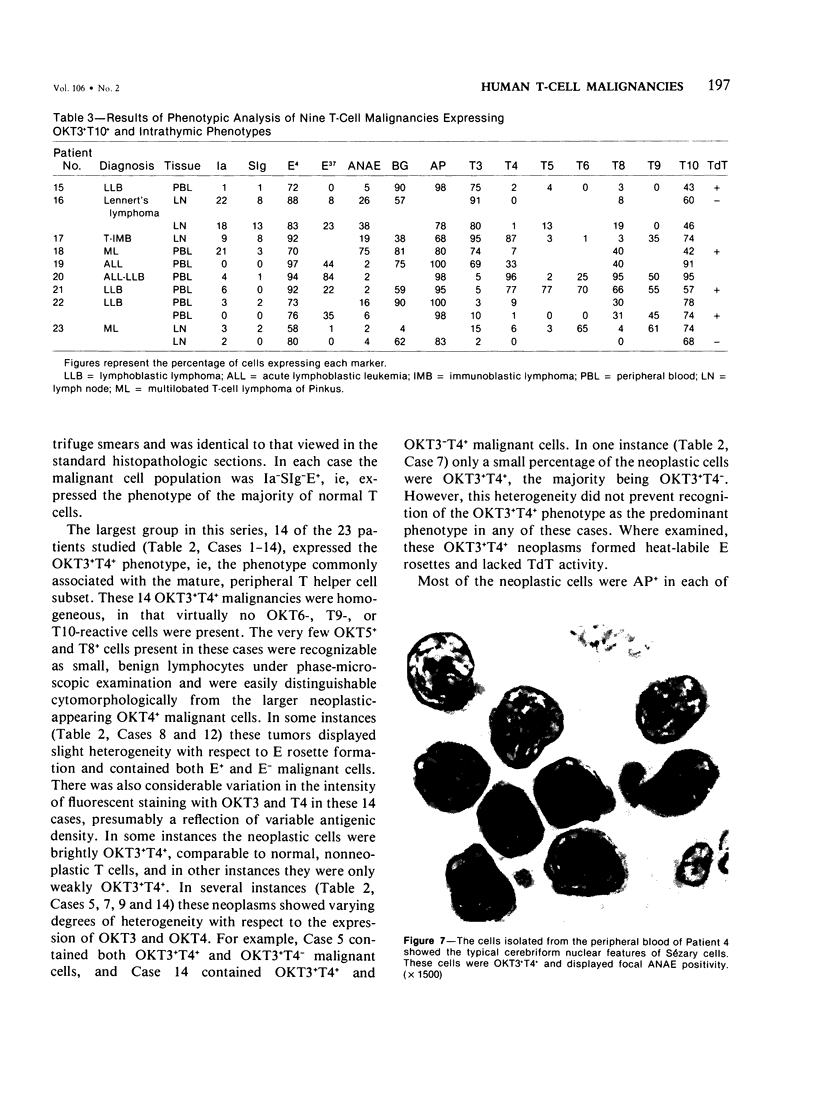
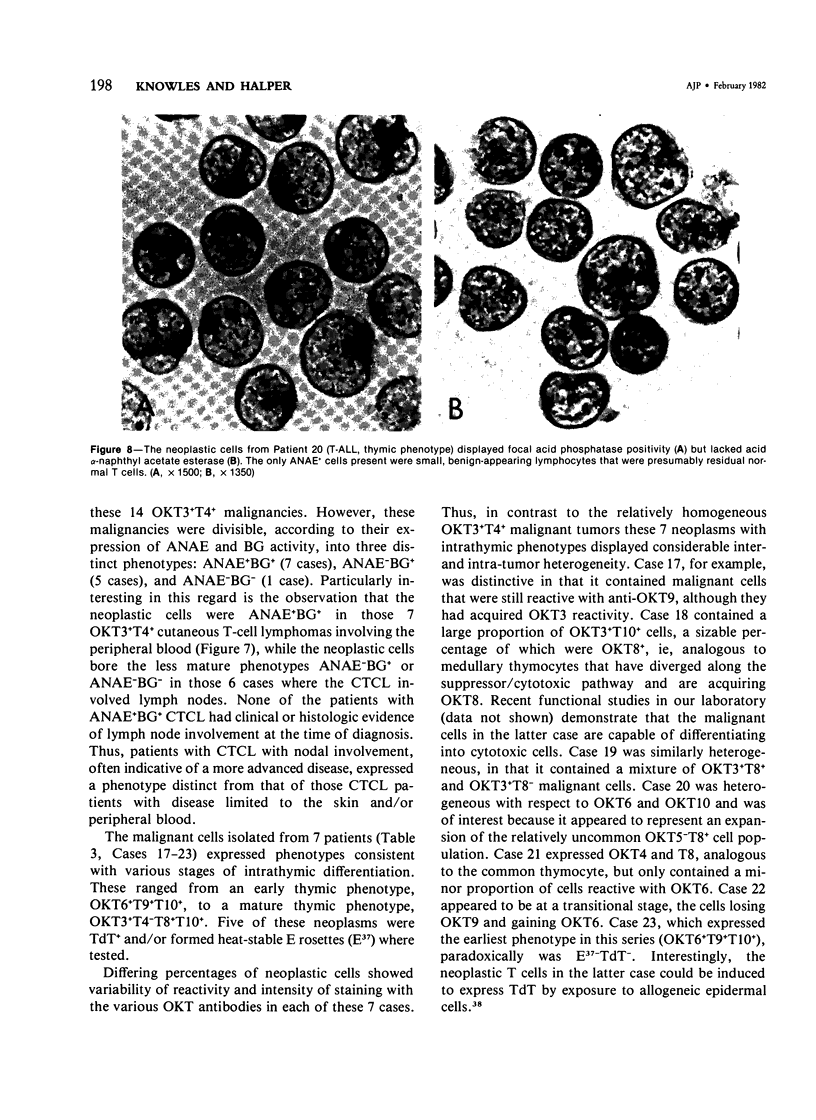
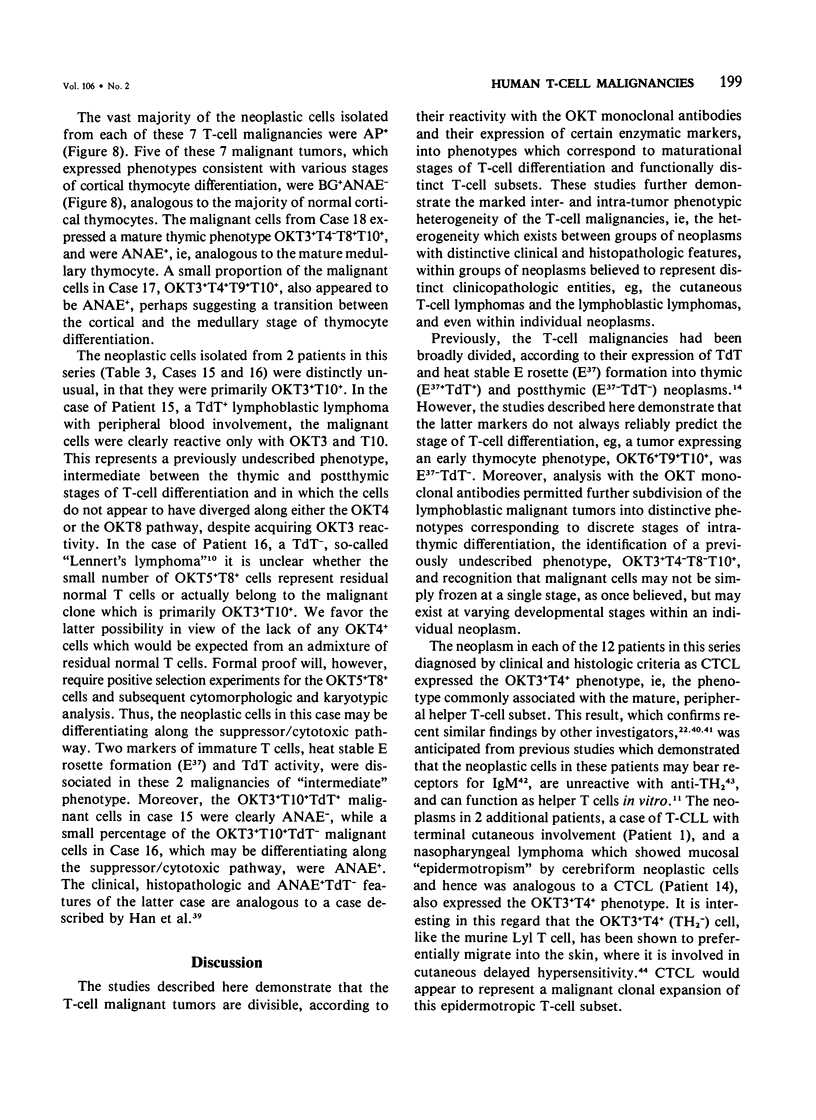
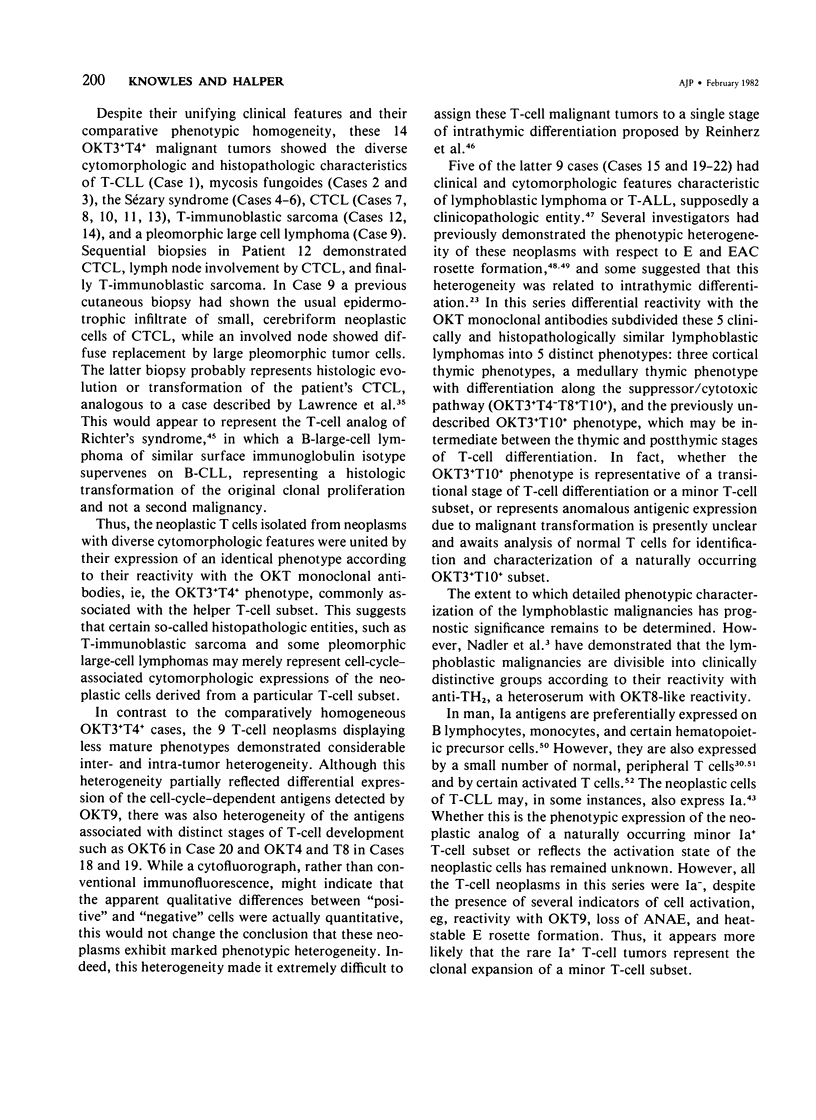
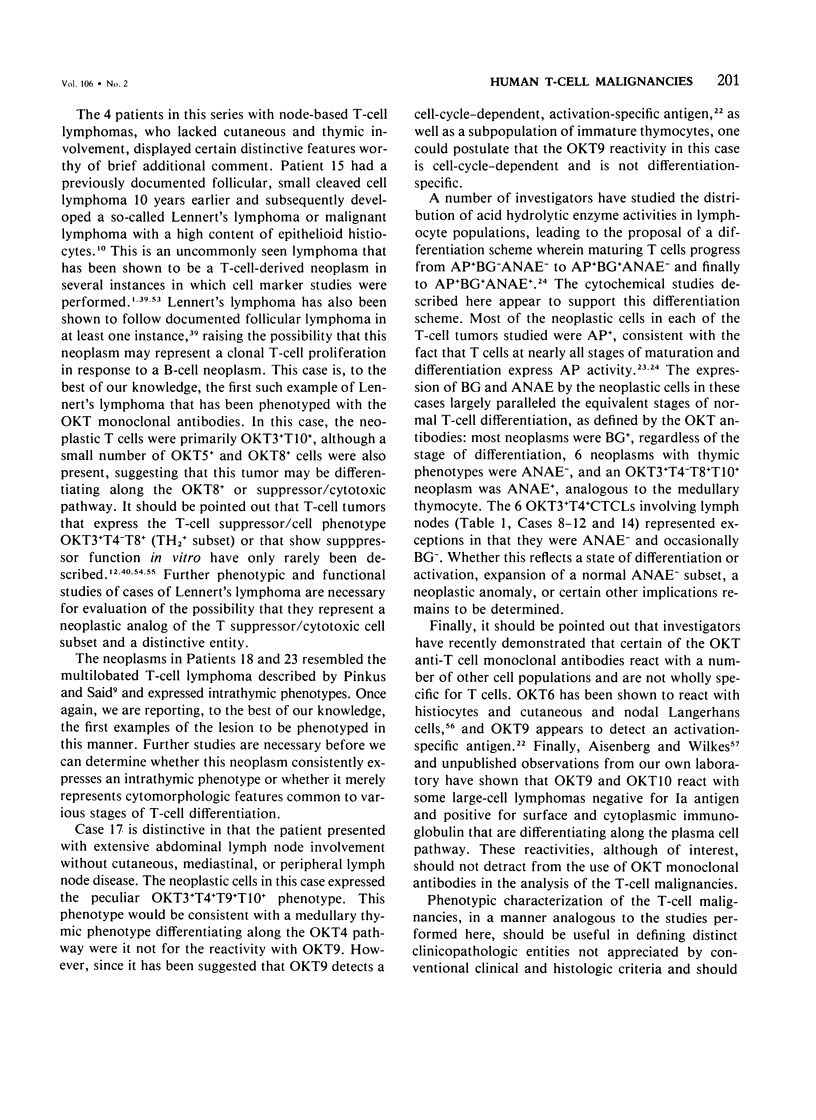
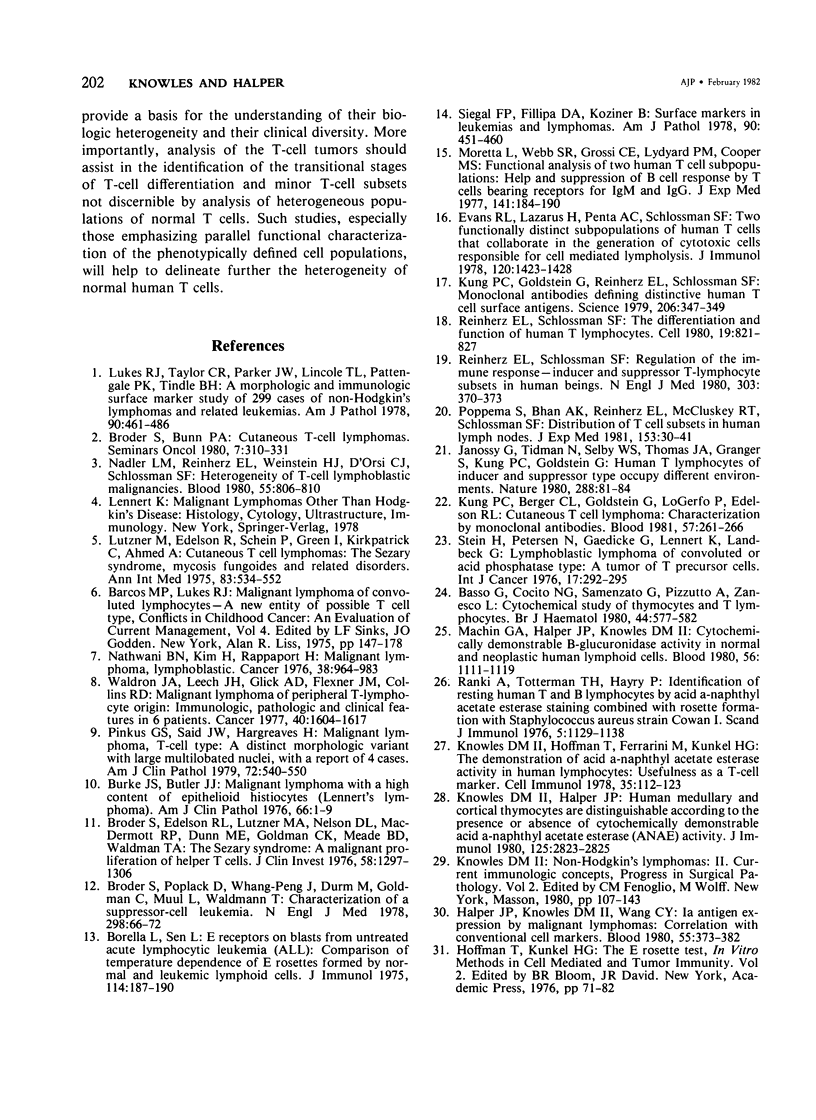
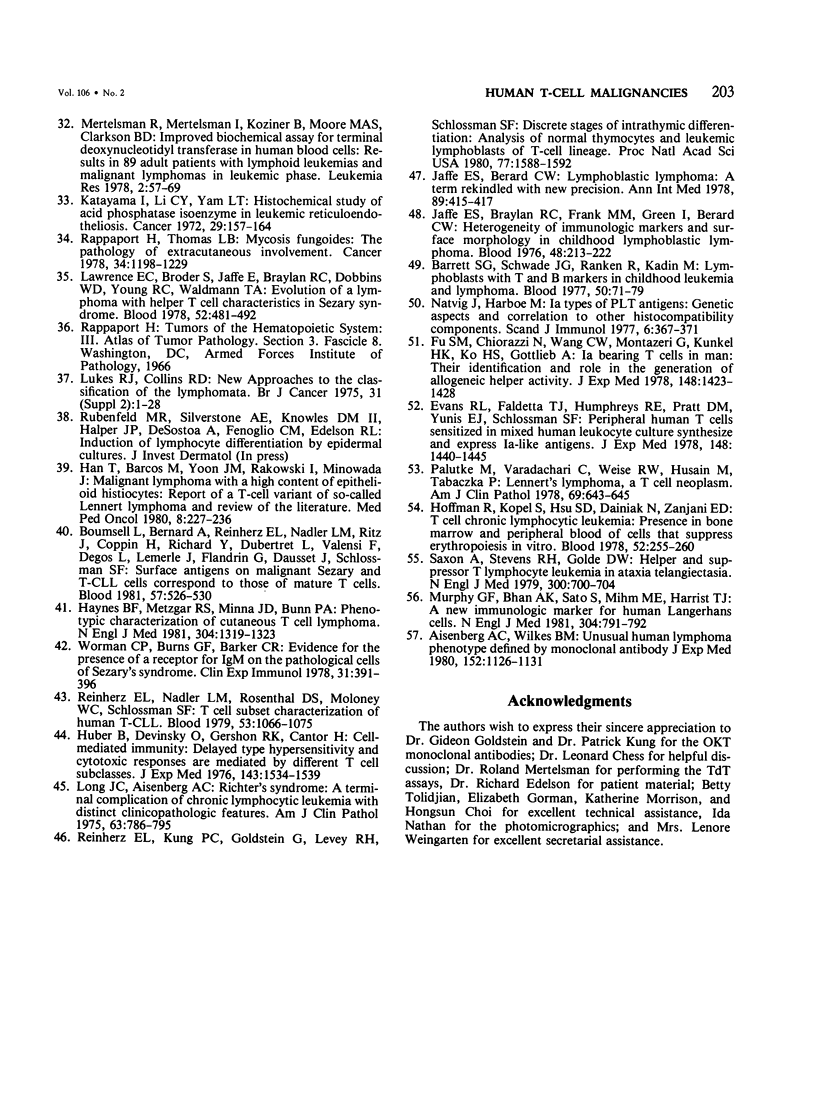
Images in this article
Selected References
These references are in PubMed. This may not be the complete list of references from this article.
- Aisenberg A. C., Wilkes B. M. Unusual human lymphoma phenotype defined by monoclonal antibody. J Exp Med. 1980 Oct 1;152(4):1126–1131. doi: 10.1084/jem.152.4.1126. [DOI] [PMC free article] [PubMed] [Google Scholar]
- Barrett S. G., Schwade J. G., Ranken R., Kadin M. E. Lymphoblasts with both T and B markers in childhood leukemia and lymphoma. Blood. 1977 Jul;50(1):71–79. [PubMed] [Google Scholar]
- Basso G., Cocito M. G., Semenzato G., Pezzutto A., Zanesco L. Cytochemical study of thymocytes and T lymphocytes. Br J Haematol. 1980 Apr;44(4):577–582. doi: 10.1111/j.1365-2141.1980.tb08712.x. [DOI] [PubMed] [Google Scholar]
- Borella L., Sen L. E receptors on blasts from untreated acute lymphocytic leukemia (ALL): comparison of temperature dependence of E rosettes formed by normal and leukemic lymphoid cells. J Immunol. 1975 Jan;114(1 Pt 1):187–190. [PubMed] [Google Scholar]
- Boumsell L., Bernard A., Reinherz E. L., Nadler L. M., Ritz J., Coppin H., Richard Y., Dubertret L., Valensi F., Degos L. Surface antigens on malignant Sézary and T-CLL cells correspond to those of mature T cells. Blood. 1981 Mar;57(3):526–530. [PubMed] [Google Scholar]
- Broder S., Bunn P. A., Jr Cutaneous T-cell lymphomas. Semin Oncol. 1980 Sep;7(3):310–331. [PubMed] [Google Scholar]
- Broder S., Edelson R. L., Lutzner M. A., Nelson D. L., MacDermott R. P., Durm M. E., Goldman C. K., Meade B. D., Waldmann T. A. The Sézary syndrome: a malignant proliferation of helper T cells. J Clin Invest. 1976 Dec;58(6):1297–1306. doi: 10.1172/JCI108585. [DOI] [PMC free article] [PubMed] [Google Scholar]
- Broder S., Poplack D., Whang-Peng J., Durm M., Goldman C., Muul L., Waldmann T. A. Characterization of a suppressor-cell leukemia. Evidence for the requirement of an interaction of two T cells in the development of human suppressor effector cells. N Engl J Med. 1978 Jan 12;298(2):66–72. doi: 10.1056/NEJM197801122980202. [DOI] [PubMed] [Google Scholar]
- Burke J. S., Butler J. J. Malignant lymphoma with a high content of epitheloid histiocytes (Lennert's lymphoma). Am J Clin Pathol. 1976 Jul;66(1):1–9. doi: 10.1093/ajcp/66.1.1. [DOI] [PubMed] [Google Scholar]
- Evans R. L., Faldetta T. J., Humphreys R. E., Pratt D. M., Yunis E. J., Schlossman S. F. Peripheral human T cells sensitized in mixed leukocyte culture synthesize and express Ia-like antigens. J Exp Med. 1978 Nov 1;148(5):1440–1445. doi: 10.1084/jem.148.5.1440. [DOI] [PMC free article] [PubMed] [Google Scholar]
- Evans R. L., Lazarus H., Penta A. C., Schlossman S. F. Two functionally distinct subpopulations of human T cells that collaborate in the generation of cytotoxic cells responsible for cell-mediated lympholysis. J Immunol. 1978 Apr;120(4):1423–1428. [PubMed] [Google Scholar]
- Fu S. M., Chiorazzi N., Wang C. Y., Montrazeri G., Kunkel H. G., Ko H. S., Gottlieb A. B. Ia-bearing T lymphocytes in man. Their identification and role in the generation of allogeneic helper activity. J Exp Med. 1978 Nov 1;148(5):1423–1428. doi: 10.1084/jem.148.5.1423. [DOI] [PMC free article] [PubMed] [Google Scholar]
- Halper J. P., Knowles D. M., 2nd, Wang C. Y. Ia antigen expression by human malignant lymphomas: correlation with conventional lymphoid markers. Blood. 1980 Mar;55(3):373–382. [PubMed] [Google Scholar]
- Haynes B. F., Metzgar R. S., Minna J. D., Bunn P. A. Phenotypic characterization of cutaneous T-cell lymphoma. Use of monoclonal antibodies to compare with other malignant T cells. N Engl J Med. 1981 May 28;304(22):1319–1323. doi: 10.1056/NEJM198105283042202. [DOI] [PubMed] [Google Scholar]
- Hoffman R., Kopel S., Hsu S. D., Dainiak N., Zanjani E. D. T cell chronic lymphocytic leukemia: presence in bone marrow and peripheral blood of cells that suppress erythropoiesis in vitro. Blood. 1978 Jul;52(1):255–260. [PubMed] [Google Scholar]
- Huber B., Devinsky O., Gershon R. K., Cantor H. Cell-mediated immunity: delayed-type hypersensitivity and cytotoxic responses are mediated by different T-cell subclasses. J Exp Med. 1976 Jun 1;143(6):1534–1539. doi: 10.1084/jem.143.6.1534. [DOI] [PMC free article] [PubMed] [Google Scholar]
- Jaffe E. S., Berard C. W. Lymphoblastic lymphoma, a term rekindled with new precision. Ann Intern Med. 1978 Sep;89(3):415–417. doi: 10.7326/0003-4819-89-3-415. [DOI] [PubMed] [Google Scholar]
- Jaffe E. S., Braylan R. C., Frank M. M., Green I., Berard C. W. Heterogeneity of immunologic markers and surface morphology in childhood lymphoblastic lymphoma. Blood. 1976 Aug;48(2):213–222. [PubMed] [Google Scholar]
- Janossy G., Tidman N., Selby W. S., Thomas J. A., Granger S., Kung P. C., Goldstein G. Human T lymphocytes of inducer and suppressor type occupy different microenvironments. Nature. 1980 Nov 6;288(5786):81–84. doi: 10.1038/288081a0. [DOI] [PubMed] [Google Scholar]
- Katayama I., Li C. Y., Yam L. T. Histochemical study of acid phosphatase isoenzyme in leukemic reticuloendotheliosis. Cancer. 1972 Jan;29(1):157–164. doi: 10.1002/1097-0142(197201)29:1<157::aid-cncr2820290124>3.0.co;2-0. [DOI] [PubMed] [Google Scholar]
- Knowles D. M., 2nd, Halper J. P. Human medullary and cortical thymocytes are distinguishable according to the presence or absence of cytochemically demonstrable acid alpha-naphthyl acetate esterase (ANAE) activity. J Immunol. 1980 Dec;125(6):2823–2825. [PubMed] [Google Scholar]
- Knowles D. M., Hoffman T., Ferrarini M., Kunkel H. G. The demonstration of acid alpha-naphthyl acetate esterase activity in human lymphocytes: usefulness as a T-cell marker. Cell Immunol. 1978 Jan;35(1):112–123. doi: 10.1016/0008-8749(78)90131-4. [DOI] [PubMed] [Google Scholar]
- Kung P. C., Berger C. L., Goldstein G., LoGerfo P., Edelson R. L. Cutaneous T cell lymphoma: characterization by monoclonal antibodies. Blood. 1981 Feb;57(2):261–266. [PubMed] [Google Scholar]
- Kung P., Goldstein G., Reinherz E. L., Schlossman S. F. Monoclonal antibodies defining distinctive human T cell surface antigens. Science. 1979 Oct 19;206(4416):347–349. doi: 10.1126/science.314668. [DOI] [PubMed] [Google Scholar]
- Lawrence E. C., Broder S., Jaffe E. S., Braylan R. C., Dobbins W. O., Young R. C., Waldmann T. A. Evolution of a lymphoma with helper T cell characteristics in Sézary syndrome. Blood. 1978 Sep;52(3):481–492. [PubMed] [Google Scholar]
- Lennert's lymphoma, a T-cell neoplasm. Am J Clin Pathol. 1978 Jun;69(6):643–647. [PubMed] [Google Scholar]
- Long J. C., Aisenberg A. C. Richter's syndrome. A terminal complication of chronic lymphocytic leukemia with distinct clinicopathologic features. Am J Clin Pathol. 1975 Jun;63(6):786–795. doi: 10.1093/ajcp/63.6.786. [DOI] [PubMed] [Google Scholar]
- Lukes R. J., Collins R. D. New approaches to the classification of the lymphomata. Br J Cancer Suppl. 1975 Mar;2:1–28. [PMC free article] [PubMed] [Google Scholar]
- Lukes R. J., Taylor C. R., Parker J. W., Lincoln T. L., Pattengale P. K., Tindle B. H. A morphologic and immunologic surface marker study of 299 cases of non-Hodgkin lymphomas and related leukemias. Am J Pathol. 1978 Feb;90(2):461–486. [PMC free article] [PubMed] [Google Scholar]
- Lutzner M., Edelson R., Schein P., Green I., Kirkpatrick C., Ahmed A. Cutaneous T-cell lymphomas: the Sézary syndrome, mycosis fungoides, and related disorders. Ann Intern Med. 1975 Oct;83(4):534–552. doi: 10.7326/0003-4819-83-4-534. [DOI] [PubMed] [Google Scholar]
- Machin G. A., Halper J. P., Knowles D. M., 2nd Cytochemically demonstrable B-glucuronidase activity in normal and neoplastic human lymphoid cells. Blood. 1980 Dec;56(6):1111–1119. [PubMed] [Google Scholar]
- Moretta L., Webb S. R., Grossi C. E., Lydyard P. M., Cooper M. D. Functional analysis of two human T-cell subpopulations: help and suppression of B-cell responses by T cells bearing receptors for IgM or IgG. J Exp Med. 1977 Jul 1;146(1):184–200. doi: 10.1084/jem.146.1.184. [DOI] [PMC free article] [PubMed] [Google Scholar]
- Murphy G. F., Bhan A. K., Sato S., Mihm M. C., Jr, Harrist T. J. A new immunologic marker for human Langerhans cells. N Engl J Med. 1981 Mar 26;304(13):791–792. doi: 10.1056/NEJM198103263041320. [DOI] [PubMed] [Google Scholar]
- Nadler L. M., Reinherz E. L., Weinstein H. J., D'Orsi C. J., Schlossman S. F. Heterogeneity of T-cell lymphoblastic malignancies. Blood. 1980 May;55(5):806–810. [PubMed] [Google Scholar]
- Nathwani B. N., Kim H., Rappaport H. Malignant lymphoma, lymphoblastic. Cancer. 1976 Aug;38(2):964–983. doi: 10.1002/1097-0142(197608)38:2<964::aid-cncr2820380248>3.0.co;2-v. [DOI] [PubMed] [Google Scholar]
- Pinkus G. S., Said J. W., Hargreaves H. Malignant lymphoma, T-cell type. A distinct morphologic variant with large multilobated nuclei, with a report of four cases. Am J Clin Pathol. 1979 Oct;72(4):540–550. doi: 10.1093/ajcp/72.4.540. [DOI] [PubMed] [Google Scholar]
- Poppema S., Bhan A. K., Reinherz E. L., McCluskey R. T., Schlossman S. F. Distribution of T cell subsets in human lymph nodes. J Exp Med. 1981 Jan 1;153(1):30–41. doi: 10.1084/jem.153.1.30. [DOI] [PMC free article] [PubMed] [Google Scholar]
- Ranki A., Tötterman T. H., Häyry P. Identification of resting human T and B lymphocytes by acid alpha-naphthyl acetate esterase staining combined with rosette formation with Staphylococcus aureus strain Cowan 1. Scand J Immunol. 1976;5(10):1129–1138. doi: 10.1111/j.1365-3083.1976.tb00254.x. [DOI] [PubMed] [Google Scholar]
- Rappaport H., Thomas L. B. Mycosis fungoides: the pathology of extracutaneous involvement. Cancer. 1974 Oct;34(4):1198–1229. doi: 10.1002/1097-0142(197410)34:4<1198::aid-cncr2820340431>3.0.co;2-e. [DOI] [PubMed] [Google Scholar]
- Reinherz E. L., Kung P. C., Goldstein G., Levey R. H., Schlossman S. F. Discrete stages of human intrathymic differentiation: analysis of normal thymocytes and leukemic lymphoblasts of T-cell lineage. Proc Natl Acad Sci U S A. 1980 Mar;77(3):1588–1592. doi: 10.1073/pnas.77.3.1588. [DOI] [PMC free article] [PubMed] [Google Scholar]
- Reinherz E. L., Nadler L. M., Rosenthal D. S., Moloney W. C., Schlossman S. F. T-cell-subset characterization of human T-CLL. Blood. 1979 Jun;53(6):1066–1075. [PubMed] [Google Scholar]
- Reinherz E. L., Schlossman S. F. Current concepts in immunology: Regulation of the immune response--inducer and suppressor T-lymphocyte subsets in human beings. N Engl J Med. 1980 Aug 14;303(7):370–373. doi: 10.1056/NEJM198008143030704. [DOI] [PubMed] [Google Scholar]
- Reinherz E. L., Schlossman S. F. The differentiation and function of human T lymphocytes. Cell. 1980 Apr;19(4):821–827. doi: 10.1016/0092-8674(80)90072-0. [DOI] [PubMed] [Google Scholar]
- Saxon A., Stevens R. H., Golde D. W. Helper and suppressor t-lymphocyte leukemia in ataxia telangiectasia. N Engl J Med. 1979 Mar 29;300(13):700–704. doi: 10.1056/NEJM197903293001303. [DOI] [PubMed] [Google Scholar]
- Siegal F. P., Filippa D. A., Koziner B. Surface markers in leukemias and lymphomas. Am J Pathol. 1978 Feb;90(2):451–460. [PMC free article] [PubMed] [Google Scholar]
- Stein H., Petersen N., Gaedicke G., Lennert K., Landbeck G. Lymphoblastic lymphoma of convoluted or acid phosphatase type-a tumor of T precursor cells. Int J Cancer. 1976 Mar 15;17(3):292–295. doi: 10.1002/ijc.2910170303. [DOI] [PubMed] [Google Scholar]
- Waldron J. A., Leech J. H., Glick A. D., Flexner J. M., Collins R. D. Malignant lymphoma of peripheral T-lymphocyte origin: immunologic, pathologic, and clinical features in six patients. Cancer. 1977 Oct;40(4):1604–1617. doi: 10.1002/1097-0142(197710)40:4<1604::aid-cncr2820400433>3.0.co;2-h. [DOI] [PubMed] [Google Scholar]
- Worman C. P., Burns G. F., Barker C. R. Evidence for the presence of a receptor for IgM on the pathological cells of Sézary's syndrome. Clin Exp Immunol. 1978 Mar;31(3):391–396. [PMC free article] [PubMed] [Google Scholar]










